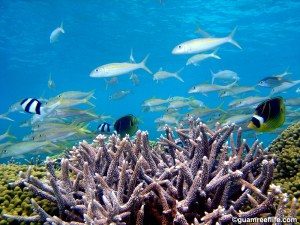Not surprisingly, one of the main contributors to the economies of coastal areas near coral reefs is ecotourism. People come from all over the world to areas with vibrant and healthy coral reefs largely for the aesthetic pleasure they provide. Recent progress has been made, in fact, to allow us to mathematically measure aesthetic appearance of reefs, and these values are also correlated with the general health of the reefs³. This is extremely significant for economies relying on ecotourism of coral reefs, as this can be done for very little cost, and can help to monitor the physical beauty and health of the reefs that bring in large amounts of revenue from drawing in ecotourists.
However, even though these economies rely heavily on the ecotourism of these reefs, there are still quite often conflicts of interest. These exist between those wanting to preserve reefs in the interest of ecotourism and those who bring in revenue via other forms of tourism. For example, in Bermuda, there has recently been conflict concerning the construction of wider and deeper pathways for cruise ships bringing in tourists. The danger for coral reefs nearby lies in the risk of their being smothered overtime by the mass amounts of sediment brought up by heavy ship traffic¹. The permanent damage or loss of these reefs would have a huge negative impact on the revenue brought in by ecotourism in Bermuda.
Even though some may argue that there is always the possibility of restoration of these reefs, although it is typically physically possible, just because a reef is restored, does not guarantee that it will survive long-term. Also, it is not always financially feasible to restore reef ecosystems. In 2010, the average restoration cost of one hectare was about $1,600,000, with the total cost often being two to four times greater¹.
The good news is that in some cases, there are new ways of getting funds to preserve revenue earning reefs. Because the divers that visit these reefs prefer healthier reefs over damaged or dying ones, it has been found that most of these individuals (with regards to reefs in Guam) are more than willing to contribute to reef management via fees when diving (Image 1). If required, this could potentially positively benefit many reefs heavily visited by ecotourists .

Image 1. Several divers in the “Blue Hole” site of Guam. (Source:http://www.guamreeflife.com/reef-conservation/importance-of-guams-reefs/)
In Guam’s reefs alone, it was estimated that large fish biomass brought in about $2 million a year (Image 2) and the presence of sharks and turtles together brought in anywhere from $15-20 million in a year². The preservation of these reefs should at the very least gain more attention by policy makers for not only the large revenue they currently bring in, but for the potential economic disasters that could take place if such vital revenue were to be lost.

Image 2. A school of fish around one of Guam’s reefs. (Source: http://www.guamreeflife.com/reef-conservation/importance-of-guams-reefs/)
References:

